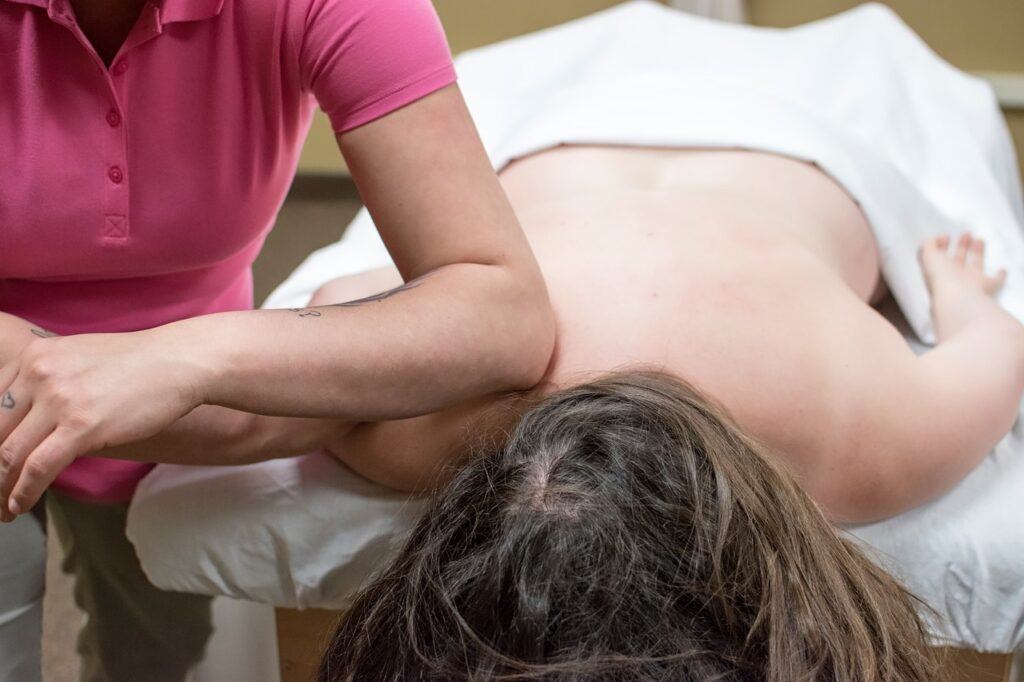Upper back pain can be as debilitating as it is common, affecting a vast portion of the population at some point in their lives. It can stem from a variety of causes including poor posture, injury, or underlying health conditions such as arthritis. Finding relief often leads to a search for natural remedies, which have become popular for their minimal side effects and accessibility.

Natural remedies for upper back pain relief encompass a range of options, from simple at-home treatments like applying heat or cold to engaging in specific exercises designed to strengthen the muscles and improve flexibility. Many people find these methods effective for managing mild to moderate discomfort before exploring more intensive medical interventions.
Key Takeaways
- Upper back pain can arise from various causes, and natural remedies provide accessible treatment options.
- At-home treatments like heat application, stretching, and exercises can effectively alleviate discomfort.
- It’s important to consider preventive measures and, if necessary, seek professional care for persistent pain.
- Upper back pain, while less common than lower back pain, can have a significant impact on one’s quality of life, according to Cleveland Clinic.
- Individuals experiencing severe pain, including pain associated with a preexisting health condition, are advised to consult a qualified healthcare professional.
- Acupuncture, yoga, and mindfulness meditation are considered natural methods for relieving pain.
Understanding Upper Back Pain
When dealing with upper back pain, it’s crucial to identify the symptoms and underlying causes accurately to address the issue effectively and avoid potential complications.
Identifying Symptoms and Causes
Upper back pain often presents as a dull, burning, or sharp sensation between your neck and the bottom of your rib cage. Common causes include muscle strain, poor posture, stress, and tension. Conditions like a herniated disc or arthritis can also lead to discomfort in this area.
When to See a Doctor
Seek medical attention if your upper back pain is persistent or severe, especially if it’s accompanied by a fever or it becomes a disabling chronic back pain. Symptoms such as numbness or weakness in your limbs are also signs you should visit your healthcare provider.
Potential Complications
Ignoring ongoing upper back pain might lead to complications, including nerve damage or a reduction in mobility. In rare cases, persistent back pain can be a sign of serious conditions like heart attack, cancer, or osteoporosis.
Diagnostic Tests
A healthcare provider will review your medical history and perform a physical exam. Further tests such as x-rays, a computed tomography (CT) scan, electromyography (EMG), or a blood test may be recommended based on their initial findings to determine the exact cause of your pain.
Relation with Other Conditions
Upper back pain can be a standalone ailment, or it may be related to other health issues. For instance, osteoarthritis can affect the spine’s joints, while herniated discs can put pressure on nerves, causing pain in other areas of the body.
Natural Remedies for Relief
Natural remedies for upper back pain focus on reducing inflammation and tension in your muscles. You can do a lot of these comfortably at home to get some relief. Now, let’s explore a bunch of effective methods to ease that annoying upper back pain.
Exercise and Motion
Getting your body moving is essential. Regular exercise, such as walking, swimming, or cycling, can help reduce pain and improve overall back health. Make sure you include strengthening exercises to bolster the muscles supporting your upper back.
It may be difficult at first but it can help reduce the chance of future injuries.
Stretching and Flexibility
Incorporate stretching into your routine to increase flexibility and ease tension. Utilize tools like a foam roller for self-massage and myofascial release to help relax tight muscles. Start with gentle stretches and gradually increase your range of motion.
Improving Posture
Your mom was right — stop slouching! Working on improving posture, especially if you’re stuck at a computer all day, is key. Practice posture training exercises, and make sure your workspace is ergonomically set up to support your back.
Massage and Acupuncture
Massage therapy can be a fantastic way to relieve pain and loosen up those tight spots. If you’re up for trying something more traditional, acupuncture might just do the trick, targeting specific points to reduce pain and promote healing.
Mind-Body Practices
Lastly, don’t overlook the power of your mind. Practices like meditation, deep breathing, relaxation techniques, and even tai chi or yoga can help manage the stress and anxiety that might be contributing to your back pain. It’s all about keeping both your mind and body in check.
At-Home Treatments

When your upper back starts to nag, you’ve got options right at home to manage the pain. Let’s dive into some soothing remedies and lifestyle tweaks that can help you find relief without stepping out the door.
Hot and Cold Therapy
Applying a cold pack to your upper back for short bursts helps reduce swelling and numbs sharp pain. Afterward, switching to a heating pad or hot water bottle can relax your muscles and improve blood flow. Remember, no more than 20 minutes with the cold, and soothing warmth should follow.
Herbal Remedies
For a natural anti-inflammatory effect, consider turmeric. A sprinkle in your meals could aid in reducing inflammation. Other herbal applications like ointments may also provide a measure of relief from back pain.
Dietary Considerations
Your diet plays a role in inflammation. Anti-inflammatory foods, like those high in omega-3 fatty acids, might lower your back pain levels. Try incorporating foods known to fight inflammation, and monitor how your body responds.
Lifestyle Changes
Sometimes it’s as simple as giving yourself enough rest and improving sleep hygiene. A good night’s sleep can do wonders for pain. Also, focus on preventing poor posture throughout the day; when you’re ergonomic, your back feels better.
If daily activities are causing pain in your upper back, it is important to allow your body time to heal.
Preventive Measures
Taking preemptive actions can greatly reduce the risk of upper back pain. Focusing on muscle strength, avoiding harmful activities, making ergonomic changes, and engaging in regular physical activity can all serve as solid defenses against discomfort and injury.
Building Muscle Strength
To prevent upper back pain, it’s vital to strengthen the muscles supporting your spine. Incorporating exercises that target your upper back, like rows and pull-ups, can enhance muscle strength and reduce the likelihood of a fall or trauma injuring your back.
Activities to Avoid
Avoiding certain movements and postures is key in preventing muscle tension. Slouching or lifting heavy objects incorrectly puts unnecessary strain on your back muscles. Be mindful of your movements to maintain proper posture and reduce tension.
Ergonomic Adjustments
A proper ergonomic setup at your desk can make a world of difference in maintaining good posture. Adjust your chair, desk, and monitor so that your back is supported, your feet flat on the ground, and your eyes level with the top of the screen.
Regular Physical Activity
Keep your back muscles flexible and your blood flow optimal by staying active. Regular exercise, such as walking or swimming, ensures good circulation and oxygen delivery to your muscles, providing you with more energy and lessening muscle strain.
Professional Care and Follow-Up

If you’re facing upper back pain that’s impacting your day-to-day life, professional care can steer you toward relief and better function. Here’s how you can engage with healthcare providers to keep tabs on your progress.
Physical Therapy
After a consultation with your doctor, you might get a referral to a physical therapist, especially if poor movement patterns or a sedentary lifestyle is deemed a leading cause of disability in your case. Physical therapy aims at not just alleviating pain but also improving your function and teaching you movement strategies that reduce the risk of future pain. Your therapist will guide you through exercises designed to strengthen the upper back and enhance flexibility.
Continued Medical Support
Prospectively, you’ll need to uphold a relationship with your healthcare providers for continued medical support. They may prescribe medications to manage pain or recommend supplements that aid in muscle recovery. Regular medical checkups ensure that your pain is tracked and treated effectively and that any medications you’re taking are adjusted as needed.
Monitoring Progress
You and your doctor will want to keep an eye on how well your pain management strategies are working. This could include routine assessments of your back’s function and movement, scaling back or stepping up therapies, or adjusting medications. Remember, recovery is not always linear and adjustments are part of the process. If your pain persists or worsens, it’s crucial to notify your doctor immediately to reconsider your therapy plan.
Conclusion
In terms of natural remedies for upper back pain, your options range from home treatments to lifestyle adjustments. Remember, if you’re dealing with chronic back pain, it’s wise to get a professional opinion, but for those everyday aches or acute back pain, these suggestions could provide some relief.
- Take a warm bath: Heat relaxes tense muscles.
- Try yoga: It can improve your posture and decrease pain.
- Get enough rest: Proper sleep can help your body heal.
Age influences the type of back pain you might experience, with younger folks possibly benefiting more from exercise and older adults potentially requiring a gentler approach. Stick to remedies that fit your comfort and health profile.
Finally, decompress with activities that make you happy. Stress can tighten your muscles leading to more pain, so chilling out is more than just nice—it’s therapeutic. If your back pain persists, visiting a healthcare provider is a smart move. Stay active, stay balanced, and listen to your body.
Frequently Asked Questions
Exploring natural remedies can be a practical approach to managing upper back pain. Here, you’ll find straightforward advice on exercises, teas, stretches, and products that may offer relief, as well as dietary and lifestyle tips to consider.
What at-home exercises can relieve upper back pain?
Engaging in specific at-home exercises can make a significant difference in alleviating upper back pain. For instance, gentle stretches and strength-building moves designed for the thoracic region can help release tension and strengthen support muscles.
What herbal teas are effective for soothing upper back discomfort?
Drinking herbal teas like ginger, turmeric, or willow bark may offer anti-inflammatory benefits and comfort for upper back discomfort. These herbs have properties that can help to naturally reduce swelling and pain.
Are there any simple stretches that can ease upper back strain?
Yes, there are simple stretches you can do to ease upper back strain. Incorporating daily movements, such as shoulder rolls, neck tilts, and gentle twisting stretches, can contribute to reducing muscle tightness and improving range of motion.
What over-the-counter natural products can help with upper back soreness?
You might consider using topical treatments such as arnica creams or capsicum patches, which are available over-the-counter and can aid in relieving back pain naturally. These products may increase blood flow and reduce inflammation in the affected area.
Can specific diet changes reduce inflammation and upper back pain?
Adjusting your diet to include omega-3 fatty acids, magnesium-rich foods, and plenty of fruits and vegetables can potentially reduce inflammation and alleviate pain in your upper back. Foods like salmon, almonds, and leafy greens are excellent choices.
What lifestyle changes can alleviate chronic upper back pain?
Consider implementing lifestyle changes such as improving your posture, especially if you sit for long periods, and incorporating regular physical activity to keep your back muscles strong. Also, ensure your sleep setup supports proper alignment of your spine.

